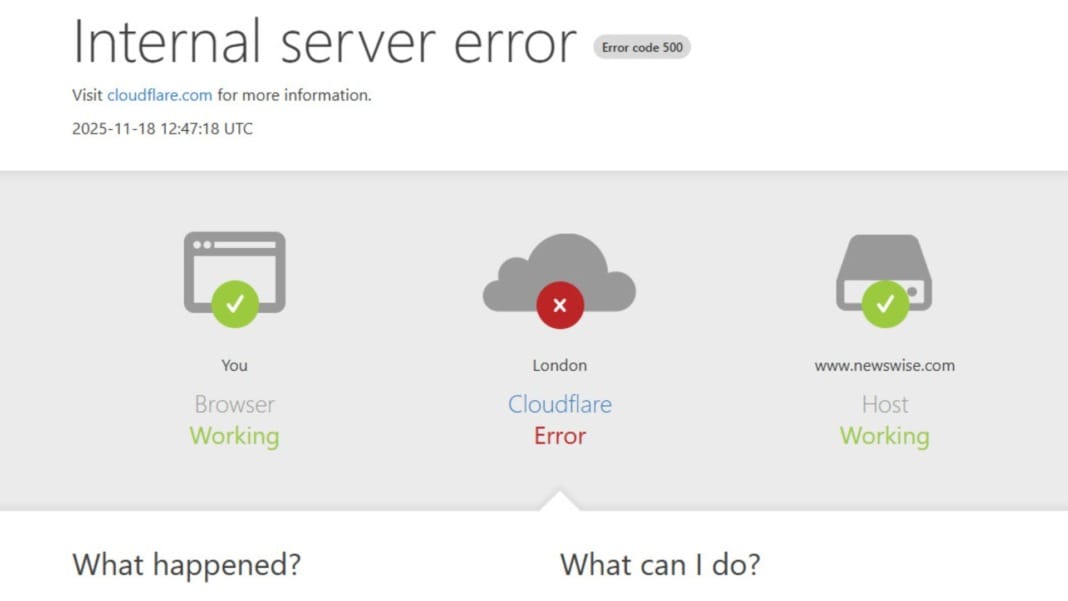A major online disruption affected users worldwide on 18 November, as many websites and digital services became temporarily inaccessible. The issue, which began early in the day, was linked to a fault involving Cloudflare. This widely used service provider supports traffic management and security functions for thousands of websites.
Cloudflare confirmed that it was experiencing significant technical problems and stated that several of its customers were affected. The company acknowledged the outage and issued a public statement saying: “Cloudflare is aware of, and investigating an issue which impacts multiple customers: Widespread 500 errors, Cloudflare Dashboard and API also failing. We are working to understand the full impact and mitigate this problem.” The error referenced in the message typically occurs when servers are unable to complete user requests, often resulting in websites being unable to load.
The disruption quickly gained attention as reports spread of popular websites becoming unreachable. Users across different regions noted slow loading times, error messages or complete service failures. Cloudflare, which supports a large share of global internet traffic, became the focus of concern as engineers began working to identify the source of the problem.
The incident comes only weeks after a major AWS outage caused several hours of downtime for many high-traffic websites, raising growing concerns about the resilience of the internet’s core infrastructure. While outages of this scale are uncommon, the back-to-back disruptions have renewed public discussion about the dependence of the modern web on a handful of major service providers.
Timeline of Cloudflare’s investigation
Cloudflare released a series of updates throughout the morning as engineers worked to stabilise the affected services. The earliest update came at 03:48 AM PT, when the company formally acknowledged the problem and confirmed that it was investigating the cause. This message marked the beginning of its ongoing communication with users and clients.
At 04:03 AM PT, Cloudflare reiterated that “we are continuing to investigate this issue,” indicating that the situation remained unresolved. The repetition of this message at 04:37 AM PT suggested that progress was slow as engineers examined the systems involved.
By 04:21 AM PT, however, Cloudflare reported a more hopeful development, noting that “we are seeing services recover.” This suggested that mitigation efforts were beginning to show results, although full resolution had not yet been confirmed. Shortly afterwards, at 04:53 AM PT, the company issued a further note stating, “We are continuing to investigate this issue,” indicating that despite some improvements, work was still ongoing to address underlying concerns.
These incremental updates provided a clear timeline of the company’s response and reflected the challenge of diagnosing complex issues across an extensive global network.
Impact on users and online services
The outage affected a wide range of websites that rely on Cloudflare for security, traffic routing and content delivery. Although the company did not specify which services were impacted, early reports from users highlighted issues with news outlets, e-commerce platforms, online tools and social media features.
For many individuals attempting to access essential websites, the error messages generated considerable confusion. Businesses relying on Cloudflare’s dashboard and API functions also faced difficulties, as the company confirmed these systems were failing during the incident. The disruption served as a reminder of how deeply interconnected online services have become and how a single outage can have immediate and widespread effects.
As Cloudflare continued its work to restore full functionality, users were advised to wait for services to recover. By late morning, signs of improvement were evident, although Cloudflare had not yet issued a final statement declaring the issue resolved.
The incident is expected to prompt further examination of system resilience, redundancy plans and the need for broader diversification across internet service providers.




